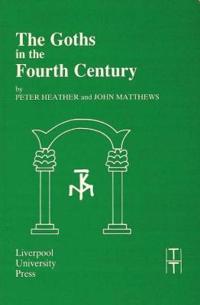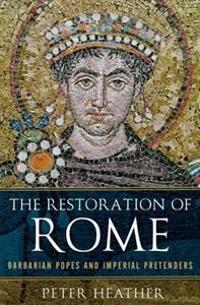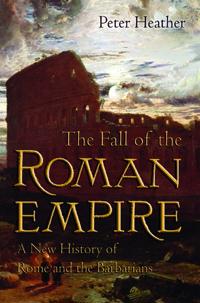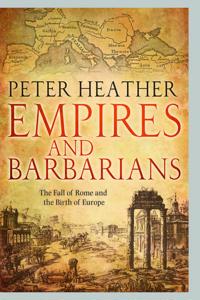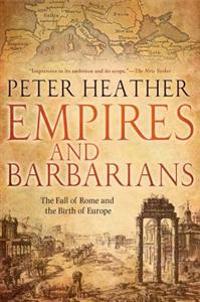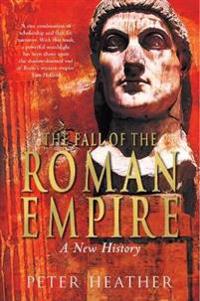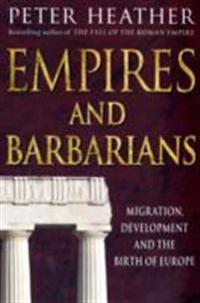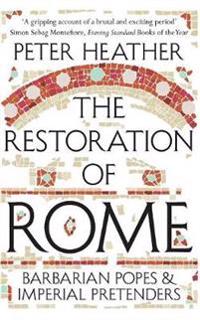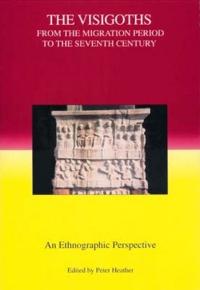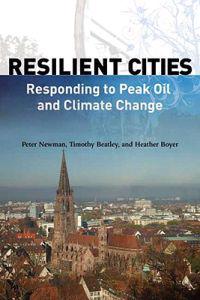The Goths in the Fourth Century (Pocket)
avPeter Heather, John Matthews, Peter Heather
ISBN: 9780853234265 - UTGIVEN: 1991-10This volume brings together many important historical texts, the majority of them (speeches of Themistius, the "Passion of St Saba", and evidence relating to the life and work of Ulfila) not previously available in English translation.[...]
The Restoration of Rome: Barbarian Popes and Imperial Pretenders (Inbunden)
avPeter Heather, P. J. Heather
ISBN: 9780199368518 - UTGIVEN: 2014-03In 476 AD, the last of Rome's emperors, known as "Augustulus," was deposed by a barbarian general, the son of one of Attila the Hun's henchmen. With the imperial vestments dispatched to Constantinople, the curtain fell on the Roman empire in Western Europe, its territories divided among successor ki[...]
The Fall of the Roman Empire (Häftad)
avPeter Heather
ISBN: 9780195325416 - UTGIVEN: 200706The death of the Roman Empire is one of the perennial mysteries of world history. Now, in this groundbreaking book, Peter Heather proposes a stunning new solution: Centuries of imperialism turned the neighbors Rome called barbarians into an enemy capable of dismantling an Empire that had dominated t[...]
Empires and Barbarians: The Fall of Rome and the Birth of Europe (Inbunden)
avPeter Heather
ISBN: 9780199735600 - UTGIVEN: 201002Empires and Barbarians presents a fresh, provocative look at how a recognizable Europe came into being in the first millennium AD. With sharp analytic insight, Peter Heather explores the dynamics of migration and social and economic interaction that changed two vastly different worlds--the undevelop[...]
Empires and Barbarians: The Fall of Rome and the Birth of Europe (Häftad)
avPeter Heather
ISBN: 9780199892266 - UTGIVEN: 201203Empires and Barbarians presents a fresh, provocative look at how a recognizable Europe came into being in the first millennium AD. With sharp analytic insight, Peter Heather explores the dynamics of migration and social and economic interaction that changed two vastly different worlds--the undevelop[...]
The Fall of the Roman Empire (Storpocket)
avPeter Heather
ISBN: 9780330491365 - UTGIVEN: 200605In AD 378 the Roman Empire had been the unrivalled superpower of Europe for well over four hundred years. And yet, August that year saw a small group of German-speaking asylum-seekers rout a vast Imperial army at Hadrianople, killing the Emperor and establishing themselves on Roman territory. Within[...]
Empires and Barbarians (Häftad)
avPeter Heather
ISBN: 9780330492553 - UTGIVEN: 201003At the start of the first millennium AD, southern and western Europe formed part of the Mediterranean-based Roman Empire, the largest state western Eurasia has ever known, and was set firmly on a trajectory towards towns, writing, mosaics, and central heating. Central, northern and eastern Europe wa[...]
Goths (Pocket)
avPeter Heather
ISBN: 9780631209324 - UTGIVEN: 1998-04-11Between the first and seventh centuries AD, Gothic groups moved thousands of miles across the map of Europe, from the fringes of the Baltic to the shores of the Atlantic ocean. In the process, they transformed themselves from an insignificant people on the outskirts of the known world into highly mi[...]
The Restoration of Rome (Häftad)
avPeter Heather
ISBN: 9781447241072 - UTGIVEN: 2014-06In 476 AD the last of Rome's emperors was deposed by a barbarian general, the son of one of Attila the Hun's henchmen, and the imperial vestments were despatched to Constantinople. The curtain fell on the Roman Empire in Western Europe, its territories divided between successor kingdoms constructed [...]
The Visigoths from the Migration Period to the Seventh Century (Häftad)
avPeter Heather
ISBN: 9781843830337 - UTGIVEN: 2003-11Between 376 and 476 the Roman Empire in western Europe was dismantled by aggressive outsiders, 'barbarians' as the Romans labelled them. Chief among these were the Visigoths, a new force of previously separate Gothic and other groups from south-west France, initially settled by the Romans but subseq[...]
Personal Construct Psychology: New Ideas (Häftad)
avEditor:Peter Caputi, Co-Editor:Heather Foster, Co- Viney
ISBN: 9780470019436 - UTGIVEN: 2006-12-31Personal Construct Psychology: New Ideas (Övrig)
avEditor:Peter Caputi, Co-Editor:Heather Foster, Co- Viney
ISBN: 9780470713044 - UTGIVEN: 2008-06-30Resilient Cities (Inbunden)
avPeter Newman, Timothy Beatley, Heather Boyer
ISBN: 9781597264983 - UTGIVEN: 2009-01This is a visionary guide to developing cities that are livable, sustainable, and 'resilient'. Half of the world's inhabitants now live in cities. In the next twenty years, the number of urban dwellers will swell to an estimated five billion people. With their inefficient transportation systems and [...]
Resilient Cities (Pocket)
avPeter Newman, Timothy Beatley, Heather Boyer
ISBN: 9781597264990 - UTGIVEN: 2009-01This is a visionary guide to developing cities that are livable, sustainable, and 'resilient'. Half of the world's inhabitants now live in cities. In the next twenty years, the number of urban dwellers will swell to an estimated five billion people. With their inefficient transportation systems and [...]

